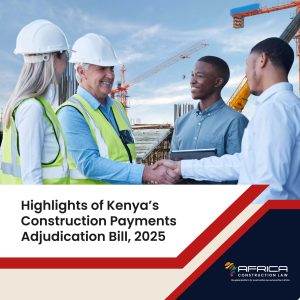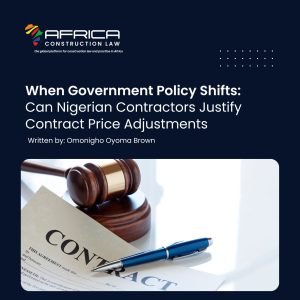Precis: It is conventional wisdom in South African construction circles that the English legal principles of “time at large” and its parent doctrine, the “prevention principle”, have no place in South African law. This begs the question: Are we looking closely enough at established principles of South African common law? In this piece, Allen & Overy’s construction team take a closer look at the South African law of contract and the remedies afforded to a delayed contractor facing liquidated damages in the context of Employer breach. The conclusion is that the South African law of contract provides a remedy similar to “time at large” via the doctrine of mora creditoris, but that – similar to its English counterpart – its application is largely curtailed by the wording of modern construction contracts.
TIME AT LARGE IN SOUTH AFRICA: MYTH OR MISUNDERSTANDING?
By: Gerhard Rudolph; Michelle Porter-Wright; Robert Thackwell; and WihanMeintjes of Allen & Overy LLP (South Africa)
The prevention principle underpins the notion of “time at large” in English law, which contractors often invoke to resist liquidated damages for late completion of works.
This principle has a long jurisprudential history in England. It provides that the contractor is relieved of its time-related obligations where an event of employer default has obstructed its timeous performance. Consequently, the liquidated damages clause loses its effect, and the contractor’s sole duty is to finish the works within a reasonable time.
English law relies on an implied term as the underlying theory for the “time at large” notion. However, the applicability of this theory is novel and uncertain in the South African legal system. Some commentators have challenged its compatibility with South African law, citing an incidental remark by Nienaber J in Group Five Building Ltd v Minister of Community Development(“Group Five”)to the effect that South African law does not recognize “time at large”.
This article explains that Nienaber J’s remarks in Group Five must be considered in their appropriate context. The Group Five case is only (persuasive)authority for the proposition that “time at large” does not exist in South African law by virtue of an implied term. However, the case does not exclude analogous legal outcomes arising from the application of recognized South African common law principles pertaining to contractual breach or “mora creditoris”.
The Group Five case: misunderstood?
In Group Five, the contractor did not seek relief from liquidated damages as a consequence of an employer breach. There was no effective liquidated damages regime. Instead, the case revolved – exclusively – around the existence or otherwise of an implied term. Group Five’s case was that the completion date was overtaken by a contrary implied term that the completion date would no longer apply where the employer was delaying the contractor’s performance. Group Five suggested it was entitled to damages for the overrun period.
It was common cause that Group Five did not advance extension of time claims under the available contractual machinery (“EOT” provisions).Rather, Group Five contended that the employer delay events in question fell outside the EOT provisions and, consequently, the powers of extension afforded to the engineer.
The court found, however, that the employer delay events cited were contemplated by the EOT provisions. The contractor should have sought extensions of time using that contractual machinery. Naturally, an implied term cannot co-exist with a contradictory express term.
Crucially, and given no liquidated damages clause was in issue, Nienaber J left open the question of an employer breach and its effect on a fixed completion date. He did, however, recognize that an employer cannot benefit from its own breach in the context of delay. He cited the case of Hansen and Schrader v Deare and other established authorities, which dictate that a building owner cannot enforce a liquidated damages clause if the delay complained of was caused by his or her agent’s default (see pages 45 – 46).
It follows that Group Five does not offer general assistance on the question of the unenforceability of liquidated damages in the context of employer breach. It is simply authority for the proposition that no implied term exists to this effect.
The suggestion that the “prevention principle” or “time at large” are fundamentally incompatible with South African law on the basis of Group Five is, therefore, unfounded.
The right to relief from liquidated damages does exist at South African common law in the face of Employer breach
As foreshadowed in Group Five, the common law position in South Africa is that contractors are relieved from liquidated damages when an employer default impedes the contractor’s performance and no contractual EOT regime exists. This position relies on mora creditoris, a type of breach by the employer that delays or hinders the contractor’s performance.
Mora creditoris may result from the employer’s failure to perform its reciprocal obligations, such as providing site access, approving designs, paying the contractor, or cooperating as needed. The contractor’s consequent delay is excused by the employer’s mora creditoris (assuming the employer default is not contemplated by any EOT provisions), noting also that concurrent mora of both parties is impossible under South African law. The employer’s mora suspends or ends the contractor’s mora.Kelly and Hingle’s Trustees v Union Government confirmed these principles and negated a penalty clause where the employer’s delay prevented timely completion absent an EOT mechanism (despite the contractor’s concurrent mora).
It follows that a South African contractor may claim that a fixed completion date is unattainable and unenforceable, with commensurate relief from liquidated damages. However, this is not based on the “prevention principle” as an implied term in English law, but on:
- the contractor’s express right to a specific scope and time frame; and
- the employer’s inability to enforce a completion obligation or penalties if it unilaterally interferes with this right without a contractual mechanism to adjust the date (mora ex re).
However, the contractor’s reliance on mora creditoris is not automatic or absolute. At common law, the contractor must prove that the employer’s delay or default caused the contractor’s delay or default, and that the contractor was ready and willing to perform its obligations but for the employer’s delay or default. The contractor must also show that it gave the employer notice of its delay or default and the reasons for it, and that it requested the employer to remedy its delay or default within a reasonable time.
When may time at large arguments be deployed in South African law?
Unfortunately for South African contractors, and much the same as the prevailing position in the United Kingdom, this argument’s efficacy is severely limited by the contractual machinery found in most modern construction contracts, including those routinely used in South Africa. Almost all standard form contracts have broadly drafted EOT mechanisms allowing contractors to claim for most acts of employer prevention, which will almost always exclude arguments negating completion dates and liquidated damage clauses premised on mora creditoris.
It follows that, and akin to the position in the United Kingdom, there are in reality only a handful of practical scenarios which may engage successful arguments based on mora creditoris in seeking to avoid liquidated damages. These arguments will be difficult to establish. They will require careful legal argument based on the wording of each contract, and cogent evidence establishing instances of employer default or frustration.
However, notionally a case akin to “time at large” on the basis of mora creditoris may be made in South Africa where:
- As in the case of Kelly and Hingle, the employer causes substantial delays or variations to the works that are not covered by the contract or exceed the contract administrator’s authority, and the contract does not allow the contractor to claim extensions of time or loss and expense for such events; and/or
- The contract administrator fails to grant extensions of time or loss and expense to the contractor in a timely and proper manner, or acts in a biased or unreasonable way, and the contract does not provide an effective dispute resolution process or alternative remedy for the contractor.
Key takeaways
Therefore, contractors should be careful and cautious before invoking or accepting a “time at large” type argument, and should consider the following takeaways:
- Contractors (and employers) should ensure that close attention is paid to the drafting of the extension of time mechanisms in their contracts;
- Contractors should follow the contract rules for claiming time and cost extensions, and document any relevant circumstances.
- Contractors should proactively negotiate and agree with the employer or contract administrator on any extensions or loss and expense, and resolve any issues that may impact the completion date or the extension process.
- Contractors should consult a lawyer before claiming or accepting a “time at large” situation, and assess the consequences and alternatives of doing so.


















